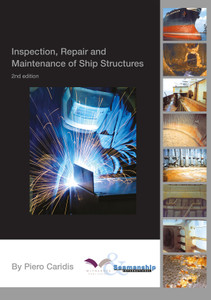
This publication explains different permutations of hatch cover type, securing devices and methods for opening and closing, as well as the various defects that may be encountered. It will benefit all those associated with the care, maintenance, operation and inspection of hatch covers (eg deck officers, deck ratings, superintendents and surveyors).
The correct operation, care and maintenance of hatch covers are critical to a ship’s safety and its ability to carry cargo without damage. This publication explains the complexities of the structure and the machinery, repairs and surveys required to ensure ongoing safety and efficiency.
During the publication process, this book was reviewed by a number of experts and interested parties, including the SKULD P&I Club who provided access to their archives to obtain a number of case studies.
1 Why Hatch Covers are Fitted to Ships
2 Background to the Design of Hatch Covers
3 Ship Construction to Accommodate Hatch Covers
4 Different Designs for Different Cargoes
5 Hatch Cover Types
6 The Differences Between Watertightness and Weathertightness
7 Care and Maintenance of Hatch Covers
8 Reasons for Hatch Cover Testing by Various Organisations and the Role of the Marine Surveyor in these Tests
9 The Various Hatch Cover Testing Methods
10 The Use of Ultrasound Testing Equipment, Principles and Operation of the varied Equipment Available on the Market
11 Client Approval of Ultrasound Testing Equipment and Operators
12 Common Defects Found when Hatch Cover Testing
13 Repairs to Hatch Covers
Case Studies
Case Study 1: Hatch covers leaking in gale force winds
Case Study 2: Leaking hatch covers – damaged steel coils cargo
Case Study 3: Water ingress through hatch covers on a refrigerated vessel
Case Study 4: Port of refuge required
Case Study 5: Oil leakage from the hatch hydraulic system on to the cargo
Case Study 6: Water damage due to leaking hatch covers
Case Study 7: Alleged wet damage to frozen krill
Case Study 8: Water damage to fishmeal cargo
Case Study 9: Steel cargo damage – ship sweat and sea water
Case Study 10: Water-soaked cargo
Appendices
Appendix 1: Resolution MSC.169(79), Standards for Owners’ Inspection and Maintenance of Bulk Carrier Hatch Covers
Appendix 2: Table Showing Comparison of Ultrasound Equipment
Mike Wall joined Cunard Line as a marine engineer apprentice at the age of seventeen, eventually reaching the rank of Chief Engineer, with service aboard many different types of ship.
During his career Mike obtained a Class 1 marine engineer’s certificate of competency, a Bachelor of Science in Maritime Studies and Master of Science degree in Shipping and Maritime Studies. Experience was gained in most areas of shipping with eight years as a lecturer in Maritime Studies, culminating in five years as Senior Lecturer as Warsash College of Maritime Studies, UK.
Twenty years’ experience was gained then in hull, machinery, cargo and condition surveys in the USA, New Zealand, Fiji and South East Asia. Mike is also a qualified Mediator, registered both in the UK and Hong Kong.
- Number of Pages:
- 178
- ISBN:
- 9781856093446
- Published Date:
- January 2008
- Binding Format:
- Paperback
- Book Height:
- 300 mm
- Book Width:
- 210 mm
- Weight:
- 0.9 kg
- Author:
Michael Ronald Wall
- Preview:
- Yes





